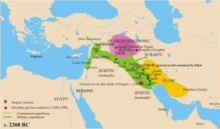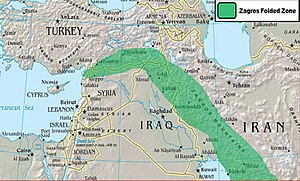User:Torivar/sandbox
Diyarbakir (Amed):
History[edit]
Kurdish history[edit]
The region witnessed several ancient Kurdish entities, some of which belong to the ancestors of the Kurds in the region from the Aryan peoples.
Hurrians (Bronze Age, Ancient Near East)[edit]
Hurrians 𒄷𒌨𒊑 were a people of the Bronze Age Near East. They spoke a Hurro-Urartian language called Hurrian and lived in Anatolia, Syria and Northern Mesopotamia. The largest and most influential Hurrian nation was the kingdom of Mitanni, its ruling class perhaps being Indo-Iranian speakers. The population of the Indo-European-speaking Hittite Empire in Anatolia included a large population of Hurrians, and there is significant Hurrian influence in Hittite mythology. By the Early Iron Age, the Hurrians had been assimilated with other peoples. Their remnants were subdued by a related people that formed the state of Urartu. The present-day Kurds and Armenians are an amalgam of the Indo-European groups with the Hurrians and Urartians.[1][2]

Gutians (22nd century BC)[edit]
Gutians (Sumerian: 𒄖𒋾𒌝𒆠,Gu-ti-umki). were ancient people settled in the Zagros Mountains in the 22nd century BC during the era of the Akkadians, one of the Indo-European peoples.[3][4][5] Their homeland was known as Gutium.[6]


The Medes (11th century BC - 549 BC)[edit]
The Medes were the people of the ancient Zagros, from which the Kurdish people descended and their homeland, according to the current geography, includes Kurdistan, Red Kurdistan, and Corduene. They ruled Amed for about 129 years, until the fall of the empire at the hands of Cyrus the Great, to be replaced by the Achaemenids, who are also from the Aryan peoples.[7]
Corduene (4th century BC)[edit]
The site of the Corduene Province, is currently located in southeastern Anatolia, south of Lake Van, west of Diyarbakir and northeast of Hakkari. The Roman emperor Pompeius the Great (106 - 48 BC) occupied the region in the first century, and it became a Roman province under the name of "Cordoyne".[8]

A people called the Carduchoi are mentioned in Xenophon's Anabasis. They inhabited the mountains north of the Tigris in 401 BC, living in well-provisioned villages. They were enemies to the king of Persia,[9] as were the Greek mercenaries with Xenophon, but their response to thousands of armed and desperate strangers was hostile. They had no heavy troops who could face the battle-hardened hoplites, but they used longbows and slings effectively, and for the Greeks the "seven days spent in traversing the country of the Carduchians had been one long continuous battle, which had cost them more suffering than the whole of their troubles at the hands of the king [of Persia] and Tissaphernes put together."[10]
They have been also mentioned as Gordi by Hecataeus of Miletus c. 520 BC.
Kurdish Ottomans Eyalets (13th century - 20th century)[edit]

Diyarbakir Eyalet was the center of the large and small Kurdish Emirates.[11][12] Which was succeeded by Kurdistan Eyalet in the nineteenth century.
Sources[edit]
- ^ Mallory, J. P.; Adams, Douglas Q., eds. (1997). "Armenians". Encyclopedia of Indo-European Culture. Fitzroy Dearborn.
- ^ Arnaiz-Villena, Antonio; Palacio-Grüber, Jose; Muñiz, Ester; Campos, Cristina; Alonso-Rubio, Javier; Gomez-Casado, Eduardo; Salih, Shadallah Fareq; Martin-Villa, Manuel; Al-Qadi, Rawand (23 January 2017). "Genetic HLA Study of Kurds in Iraq, Iran and Tbilisi (Caucasus, Georgia): Relatedness and Medical Implications". PLOS ONE. 12 (1): e0169929. Bibcode:2017PLoSO..1269929A. doi:10.1371/journal.pone.0169929. PMC 5256937. PMID 28114347.
{{cite journal}}: CS1 maint: unflagged free DOI (link) - ^ "Encyclopedia of the Peoples of Africa and the Middle East". Archived from the original on 28 May 2016.
- ^ The Sumerian King ListArchived 2010-08-30 at the Wayback Machine. Accessed 19 Dec 2010.
- ^ Van De Mieroop, Marc. "GUTIANS". Archived from the original on 24 May 2018. Retrieved 29 March 2012.
{{cite web}}: Unknown parameter|عمل=ignored (help) - ^ "The Electronic Text Corpus of Sumerian Literature". etcsl.orinst.ox.ac.uk. Retrieved 2020-12-12.
- ^ iranicaonline.org https://iranicaonline.org/articles/media. Retrieved 2020-12-12.
{{cite web}}: Missing or empty|title=(help) - ^ "Cassius Dio — Book 37". penelope.uchicago.edu. Retrieved 2020-12-13.
{{cite web}}: no-break space character in|title=at position 19 (help) - ^ Anabasis by Xenophon, Book III, chapter V
- ^ Anabasis by Xenophon, Book IV, chapter III
- ^ "Kurdish Notables and the Ottoman State: Evolving Identities, Competing ... - Hakan Ozoglu, Hakan Özo?lu - Google Livres". web.archive.org. 2020-11-24. Retrieved 2020-12-12.
- ^ "The Formation of Ottoman Kurdistan: Social, Economic and Political Developments in Ottoman Kurdistan before the Nineteenth Century (1514–1800) (Chapter 2) - The Political Economy of the Kurds of Turkey". web.archive.org. 2017-12-01. Retrieved 2020-12-12.
